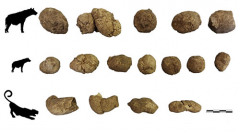

 Comptes Rendus Palevol
18 (1) - Pages 113-141
Comptes Rendus Palevol
18 (1) - Pages 113-141This paper presents a study of the macromammalian fauna recovered from Mousterian levels of Llonin Cave. The sample is highly heterogeneous and comprises six species of ungulates, including Rupicapra pyrenaica, Capra pyrenaica, and Cervus elaphus, and seven species of carnivores, predominantly Ursus spelaeus, Crocuta spelaea, Canis/Cuon and Panthera pardus. The archaeozoological and taphonomic study of the remains shows preferential use of basal levels of the cave as a den for hyenas and leopards. Neanderthals were also present during this phase and they would have acted mainly on deer and some caprines, while the action of hyenas would mainly have been linked to scavenging of elements left by humans and the introduction of bear remains. Leopards would have transported caprines in order to consume them. The study of several coprolites confirms that hyenas and leopards were the main occupants of the cave. The information from the animals processed by humans together with other archaeological evidence and the intervention of various carnivores in these basal levels enables us to characterise a palimpsest of occupations that would have been short and sporadic in the case of humans.
Human-carnivore interactions, Neanderthal subsistence, Middle Palaeolithic, Hyenas, Leopards